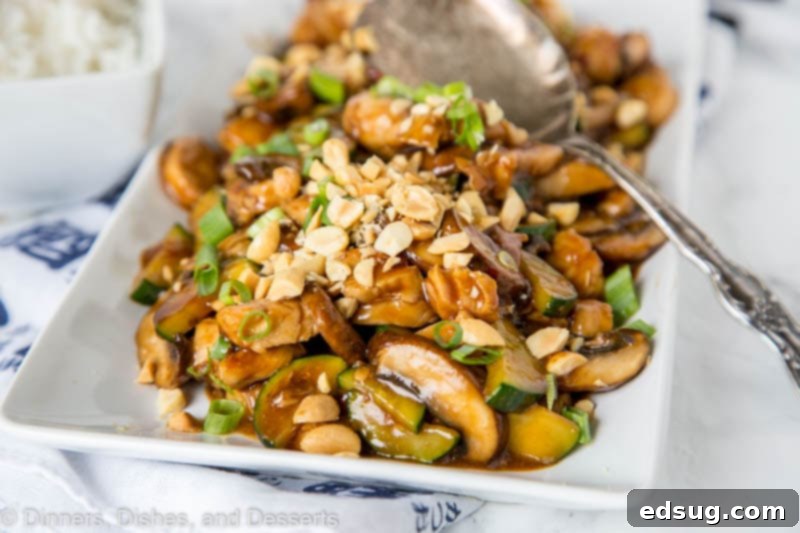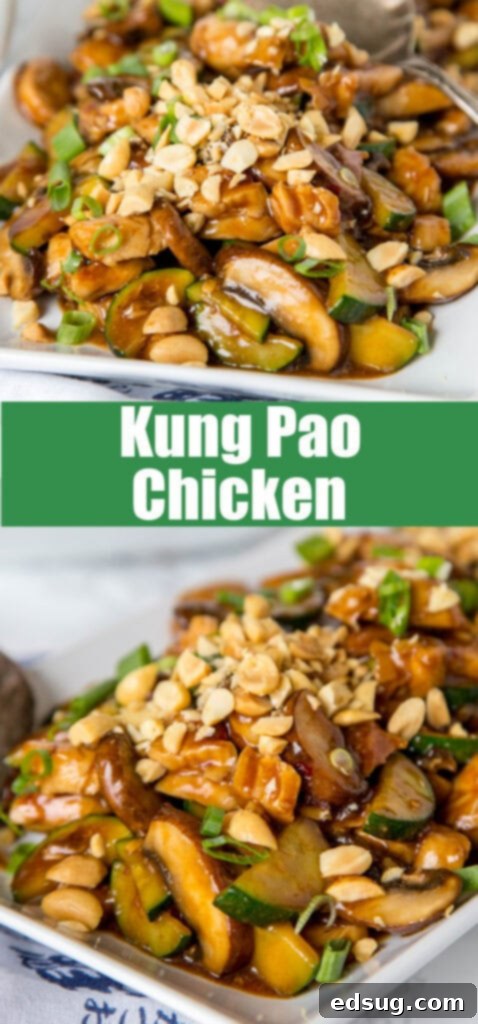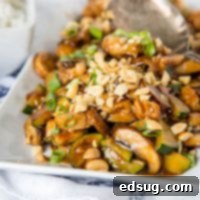The Best Homemade Kung Pao Chicken: Quick, Spicy & Customizable Stir-Fry Recipe
Dive into the irresistible flavors of homemade Kung Pao Chicken – a quick and easy stir-fry recipe packed with vibrant veggies and a delightful spicy kick. Customize with your favorite vegetables and have a delicious dinner ready in minutes!
For many across the United States, Asian takeout is a beloved culinary tradition, and it’s easy to see why. The convenience and incredible flavors are undeniably appealing! However, what if we told you that many of your favorite Chinese restaurant dishes, like the classic Kung Pao Chicken, can be prepared right in your own kitchen – often tasting even better?
Making Asian-inspired dishes at home offers numerous advantages. Not only can you achieve a fresher, more authentic taste, but you also gain complete control over the ingredients. This means you can tailor the spice level to your preference, adjust the amount of salt and sugar, and incorporate all the vegetables your family loves – or simply use whatever you have on hand. It’s about creating a meal that perfectly suits your palate and dietary needs, without any hidden surprises.

Kung Pao Chicken holds a prominent place on nearly every Chinese takeout menu, and for good reason. It’s a fantastic balance of savory, sweet, and spicy, with a wonderful textural contrast from the tender chicken, crisp vegetables, and crunchy peanuts. The best part? This beloved dish is surprisingly simple to recreate at home, making it an ideal choice for a busy weeknight dinner. Its versatility also means you can easily adapt it to your preferences, making it a family-friendly meal everyone will enjoy.
What is Kung Pao Chicken?
Kung Pao Chicken is a renowned stir-fry dish originating from the Sichuan province of China. Traditionally, it features diced chicken, peanuts, and a medley of vegetables, all tossed in a signature spicy, sweet, and tangy sauce. While traditional versions often include dried chili peppers and Sichuan peppercorns for a unique numbing-spicy (ma la) sensation, many Americanized recipes adapt this profile to suit a broader palate, often relying on chili garlic paste for its fiery kick.
One of the aspects I particularly love about making homemade Kung Pao Chicken is its inherent flexibility. You truly can add almost any vegetables you have in your fridge. Got a zucchini that needs to be used? Toss it in! A handful of broccoli florets? They’ll be perfect. This adaptability makes it a zero-waste dinner hero and a consistently fresh meal.
This Kung Pao Chicken recipe is a personal favorite for weeknight dinners precisely because of how quickly and effortlessly it comes together. Furthermore, the heat level is entirely adjustable to your family’s taste. My family enjoys a good amount of spice, so I tend to be generous with the chili garlic paste. However, if you prefer a milder flavor, simply reduce the amount – it’s that easy to customize!

Why Choose Homemade Over Takeout?
While takeout offers convenience, preparing Kung Pao Chicken from scratch provides several compelling benefits. Firstly, you control the quality and freshness of every ingredient. You know exactly what goes into your meal, allowing you to avoid artificial additives, excessive sodium, or unwanted sugars often found in restaurant dishes. Secondly, it’s a more cost-effective option, stretching your dollar further while still delivering an incredibly satisfying meal.
Moreover, homemade allows for customization that takeout simply can’t match. Do you have a peanut allergy? No problem, you can easily omit them or substitute with another nut. Want extra veggies or a specific type? You’re the chef! This recipe empowers you to create a personalized culinary experience tailored to your family’s preferences and dietary needs, making dinner both delicious and mindful.
Essential Kung Pao Chicken Ingredients
The magic of Kung Pao Chicken lies in its distinctive sweet and spicy sauce. What’s even better is that this flavorful sauce is crafted from a few basic pantry staples that you likely already have on hand. The combination of these ingredients creates a perfectly balanced flavor profile that coats the chicken and vegetables beautifully.
- Chicken Broth: Forms the liquid base of the sauce, adding depth.
- Soy Sauce: Provides the essential umami and salty foundation for Asian cuisine. Consider low-sodium options or tamari for gluten-free.
- Sesame Oil: Delivers a nutty, aromatic essence that is crucial for authentic flavor.
- Cornstarch: Acts as a thickening agent, giving the sauce its desirable glossy consistency.
- Chili Garlic Paste: The primary source of heat and pungent garlic flavor. Adjust according to your spice preference.
- Rice Wine Vinegar: Adds a bright, tangy element that balances the sweetness and spice.
- Brown Sugar: Contributes sweetness and a subtle molasses note, rounding out the sauce.
Beyond the sauce, you’ll need boneless, skinless chicken (breasts or thighs work well), your choice of vegetables, vegetable oil for stir-frying, fresh garlic, and green onions for garnish. And, of course, the traditional peanuts!
Is Kung Pao Chicken Meant to Be Spicy?
Absolutely, traditional Kung Pao Chicken is indeed known for its spicy kick! It’s a hallmark of Sichuan cuisine. However, the beauty of making this dish at home is that you have complete control over the heat level. You can dial it up or down to suit your personal preference or your family’s tolerance for spice. If you love a fiery meal, don’t shy away from adding more chili garlic paste. For those who prefer a milder experience, a smaller amount will provide flavor without overwhelming heat. Some even like to add a pinch of dried red chili flakes for extra visual appeal and a different kind of heat.
Does Kung Pao Chicken Traditionally Have Peanuts?
Yes, peanuts are a very traditional and integral component of Kung Pao Chicken. They contribute a wonderful crunch and a nutty flavor that perfectly complements the savory, sweet, and spicy elements of the dish. If you or someone you’re cooking for has a peanut allergy, you can certainly leave them out entirely. Alternatively, for those who enjoy nuts but need an alternative, chopped cashews or almonds can offer a similar textural and flavor profile. Interestingly, when I had a version of this dish in China, it was often served with whole peanuts on top, which is a delightful visual and textural experience, different from the chopped peanuts I typically use at home.

Make your homemade take-out night truly complete by serving your Kung Pao Chicken with classic Asian sides like light and savory Egg Drop Soup, comforting Wonton Soup, or crispy Air Fryer Egg Rolls! These pairings elevate the meal, creating a restaurant-quality experience in your own dining room.
How to Master Homemade Kung Pao Chicken
Crafting the perfect Kung Pao Chicken at home is simpler than you might think, especially when you follow a few key steps. The secret to a successful stir-fry lies in preparation and precise cooking techniques.
- **Mise en Place is Key:** Before you even turn on the stove, ensure all of your **ingredients are prepped and ready**. This means your chicken should be cut into bite-sized pieces, all your chosen vegetables chopped, and your sauce mixed. Stir-fries cook incredibly fast, so having everything measured and within reach will make the cooking process smooth and stress-free.
- **Prepare Your Signature Sauce:** Mix all the ingredients for the sauce together in a liquid measuring cup or a small bowl. Whisk until thoroughly combined. Having it ready to pour in when needed prevents last-minute scrambling and ensures the sauce thickens evenly.
- **Choose the Right Cookware:** Use a wok or a very large skillet. A wok is ideal because its sloped sides allow for even cooking and easy tossing, but a large, heavy-bottomed skillet works perfectly well. Make sure the pan is nice and hot before you add any ingredients – this is crucial for achieving that characteristic stir-fry char and preventing steaming.
- **Cook Chicken Separately:** Brown the marinated chicken in the hot pan for 4-5 minutes, or until fully cooked through and slightly caramelized. Once done, remove it from the pan and cover it with foil to keep it warm. Cooking the chicken separately prevents it from overcooking and becoming tough while you sauté the vegetables.
- **Sauté the Vegetables:** Reduce the heat slightly and add your vegetable oil. Then, add your chosen vegetables (excluding quick-cooking items like green onions or water chestnuts which come later) and cook for 4-5 minutes until they are crisp-tender. Stir-frying ensures they retain a pleasant bite and vibrant color.
- **Combine and Thicken:** Once the vegetables are nearly done, add the cooked chicken back to the pan along with the garlic and water chestnuts. Pour the prepared sauce over everything. Bring the mixture to a boil, stirring constantly. Cook for 2-3 minutes, allowing the cornstarch in the sauce to thicken it to a glossy, desirable consistency.
- **Garnish and Serve:** Serve immediately over steamed rice, garnished generously with freshly chopped green onions and crunchy peanuts. Enjoy your homemade masterpiece!
Customizing Your Veggies for Kung Pao Chicken
The beauty of homemade Kung Pao Chicken lies in its flexibility, especially when it comes to vegetables. You truly can use whatever mix of vegetables you enjoy or have on hand. I typically aim for about 2-3 cups total of chopped vegetables to ensure a good balance with the chicken and sauce. Here are some popular and delicious options:
- Bell Peppers: Red, yellow, or orange bell peppers add sweetness, color, and a pleasant crunch.
- Mushrooms: Sliced button or cremini mushrooms absorb the sauce beautifully, adding an earthy umami flavor.
- Zucchini: A great way to use up garden zucchini, providing a tender texture.
- Broccoli: Florets add a hearty green and absorb the sauce well. Steam or blanch briefly before stir-frying if you prefer them softer.
- Water Chestnuts: These canned gems provide a delightful, crisp texture and subtle sweetness.
- Scallions (Green Onions): Essential for both flavor within the stir-fry and as a fresh, aromatic garnish.
- Carrots: Thinly sliced or julienned carrots add sweetness and vibrant color.
- Snap Peas or Snow Peas: For a fresh, slightly sweet crunch. Add them towards the end of cooking.
- Bok Choy: Adds a tender, slightly bitter counterpoint.
And of course, topping your finished stir-fry with a generous sprinkle of chopped peanuts just brings all the flavors and textures together, completing this incredible dish!

More Delicious Asian Dinner Recipes
If you’ve enjoyed this Kung Pao Chicken recipe, you’re in for a treat with more of our favorite Asian-inspired dinner ideas. These recipes offer a fantastic way to explore diverse flavors and expand your weeknight meal rotation, all from the comfort of your kitchen. From savory noodles to succulent chicken dishes, there’s something to satisfy every craving:
- Garlic Beef Noodle Bowls: A flavorful and hearty dish perfect for busy evenings.
- Pork Lo Mein: Classic stir-fried noodles with tender pork and crisp vegetables.
- Easy Sesame Chicken: Sweet and savory chicken, a family favorite.
- Spicy Stir Fry Noodles: Quick and versatile, customizable with your preferred spice level.
- Chow Mein Noodles with Chicken: Another beloved noodle dish, packed with chicken and veggies.
- General Tso’s Chicken: A sweet, spicy, and tangy American Chinese classic.
- Easy Cashew Chicken: A mild and nutty chicken stir-fry that’s always a hit.

Kung Pao Chicken
Pin Recipe
Rate Recipe
Print Recipe
Ingredients
- 1 pound boneless, skinless chicken breasts, cut into bite size pieces
- 5 Tablespoons white wine or chicken broth, divided
- 5 Tablespoons soy sauce, divided
- 2 Tablespoons sesame oil, divided
- 2 Tablespoons cornstarch, divided
- 2 Tablespoons water, divided
- 1 Tablespoon chili garlic paste
- 3 teaspoons rice wine vinegar
- 6 teaspoons brown sugar
- 2 teaspoons vegetable oil
- 2 cups vegetables, chopped
- 1 small can water chestnuts
- 1 Tablespoon garlic, chopped
- 2 green onions, finely chopped
- chopped peanuts, for garnish
Instructions
-
In a large zip top bag, combine 2 Tbsp wine or chicken broth, 2 Tbsp soy sauce, 1 Tbsp sesame oil, and 1 Tbsp cornstarch dissolved with 1 Tbsp water.
-
Add chicken. Toss to coat. Marinate in the fridge for 30-60 minutes.
-
Meanwhile make the sauce. Mix together 3 Tbsp wine or chicken broth, 3 Tbsp soy sauce, 1 Tbsp sesame oil, 1 Tbsp cornstarch dissolved in 1 Tbsp water, chili paste, vinegar, and brown sugar. Set aside.
-
Heat a large skillet over high heat. Add the marinated chicken. Brown the chicken for 4-5 minutes, or until it is cooked. Remove from pan, cover with foil to keep it warm.
-
Reduce the heat to medium high heat. Add vegetable oil to the pan. Mix in veggies and cook for 4-5 minutes, until crisp tender. Mix in garlic and water chestnuts. Cook for 2 minutes.
-
Add chicken back to the pan. Pour sauce over the chicken. Mix and bring to a boil. Cook for 2-3 minutes until the sauce starts to thicken.
-
Serve immediately over rice topped with green onions and chopped peanuts
Notes
Nutrition
Nutrition information is automatically calculated, so should only be used as an approximation.
Additional Info
Like this recipe? Leave a comment below!
I created a fun group on Facebook, and I would love for you to join us! It’s a welcoming place where you can share YOUR favorite recipes, ask questions, and stay updated on what’s new at Dinners, Dishes and Desserts (so you never miss a delicious new recipe)! If you’d like to check it out, you can request to join HERE.
Be sure to follow me on Instagram and tag #dinnersdishes so I can see all the wonderful DINNERS, DISHES, AND DESSERTS recipes YOU make!
Connect with Dinners, Dishes, and Desserts!
Stay connected and never miss a post from Dinners, Dishes, and Desserts! Be sure to follow me on my social media channels:
Facebook | Twitter | Pinterest | Instagram
